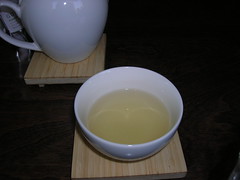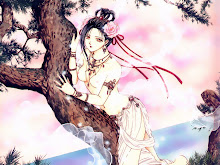Tea Time Thursdays VIII - China Green Tea
Welcome to the eighth edition of Tea Time Thursday. Today I was actually going to feature a different tea but, after trying the China Green I knew I had to write about it. I actually had an opportunity to taste this tea in the tea store the first time. A week later I was back in Gong Fu Tea to pick up some, it made that much of an impression.
I noticed that it didn't taste the same when I brewed it at home. Today I had a chance to try it again in store and was lucky enough to borrow a bit of Mike's time. During our conversation he mentioned that green teas really need a gentler temperature and a little less time to brew. So now ,per Mike, I will be picking up a thermometer to make sure the water is only 175 degrees or I will have to try letting my kettle sit for 5 minutes off the heat after bringing it to a boil. The optimal temperature of brewing green teas is 175 degrees, because if the water is hotter you release the tannins in the tea making it bitter. I'm hoping I got that right, if not Mike or Rusty please correct me.

This tea is very mellow with almost a sweet after taste. I'm in love with the how mild it taste. I was also surprised to learn that it is a green tea from China. For some odd reason I thought green teas only came from Japan. You learn something new everyday, huh?
If you like green tea I highly recommend you try the China Green. It's very nice and my current favorite. Yeah, I know that doesn't say much since I change favorites practically every week. You try drinking these teas and see if you don't fall in love with them. I dare you.
Enjoy!
I noticed that it didn't taste the same when I brewed it at home. Today I had a chance to try it again in store and was lucky enough to borrow a bit of Mike's time. During our conversation he mentioned that green teas really need a gentler temperature and a little less time to brew. So now ,per Mike, I will be picking up a thermometer to make sure the water is only 175 degrees or I will have to try letting my kettle sit for 5 minutes off the heat after bringing it to a boil. The optimal temperature of brewing green teas is 175 degrees, because if the water is hotter you release the tannins in the tea making it bitter. I'm hoping I got that right, if not Mike or Rusty please correct me.

This tea is very mellow with almost a sweet after taste. I'm in love with the how mild it taste. I was also surprised to learn that it is a green tea from China. For some odd reason I thought green teas only came from Japan. You learn something new everyday, huh?
If you like green tea I highly recommend you try the China Green. It's very nice and my current favorite. Yeah, I know that doesn't say much since I change favorites practically every week. You try drinking these teas and see if you don't fall in love with them. I dare you.
Enjoy!


3 Comments:
China green... such a vague and genric name.
I wonder what type of green tea did you have since the range of green tea that is available in China is HUGE; some possess great aroma, others that excel in its color, and still other that possess great durability.
Some famous green teas that you should perhaps try are, Long Jing (dragon well)-preferably those picked before the Qingming festival, Tie Guan Yin (The iron Guanyin(the God of mercy)), Bi Luo Chun (---), Rou Gui (---), and perhaps the famous Taiwanese Dong Ding Wu Long (frozen tip black dragon). The "shan cha" (mountain tea) is also very nice, though some find it a bit too strong for their liking.
While you now know about water temperature; 70-75c for green tea, 80-85c for fermented tea, and boiling for compressed tea (if you can, try to slow roast your compressed tea before brewing, the roasting process does add another layer of smoliness and flavour that enhances the flavor of the tea). Another thing when you make tea, any kind of tea, or coffee for that matter, is the water and the untensils that you are using.
The ideal type of water should be flowing spring water, if you couldn't procure it simple mineral mineral water would also suffice, however if price is of concern (in my case it is, since bottled mineral water is too expensive (I think) for drinking tea) purified water is adequate, while water that comes from the tap is not that ideal due to its mineral content (serious limescale growth in your kettle is a key indicator of this).
Moving on to the utensils used. Metal and plastic utensils should be avoided when making tea, this goes for everything except that of the kettle. Though a well used cast iron kettle is the best that you can get, the difficulty in getting your hand on one is immense, therefore a simple kettle would be fine, just make sure that it is regularly cleaned to rid it of limescale. Furthermore microwaved water is also frowned upon (I have asked several people why, the best answer that I have heard so far is the claim that the microwave used to heat the water destroy the natural make up of the water).
Returning to why the use of metal and plastic implements should be avoided, this is to avoid taste contamination, which does deduct a considerable amount of taste from fine and delicate flavor of well aged teas.
Therefore, if you are mindful in your observation of tea drinking you would have noticed that all utensils used in making tea are made from bamboo or clay which are rather neutral in their character.
-continue-
correction:
genric: generic
smoliness: smokiness
There are several keys in choosing your teapot (brewing utensil) and and teacups/teabowls. There are many instructions to which one could follow in choosing one's tea utensils, but for the sake of simplicity I think that the two most important ones are; One, you should be looking for utensils which possess even heat distribution and doesn't interfere with the taste of the tea. Secondly, the utensil should be of good proportion, since the depth, height, and width of the utensil does directly influence the taste of tea. To demonstrate the importance of these two points, I suggest that you conduct a imple experiment. From the same pot of tea, pour it in to the various cups and bowls that you have, then proceed to drink from it. In the case of bowls, use the big opening to your advantage stuff your nose in and while you drink your tea take a good sniff of its aroma and then let the tastes intermingle at the back of your throat. Do you notice any difference???
Before I end, I would also like to recommend a short book that will enhance your appreciation of tea drinking, "The Book of Tea" by Okakura Kakuzo (http://www.terebess.hu/english/okakura.html) I am sure that you would definitely from browsing through it.
Warm wishes,
Peking Man
Interesting blog! Hope you saw my reply to you at the (old) social board. I love green tea too. Looking forward to reading more...
~Nini
Post a Comment
<< Home